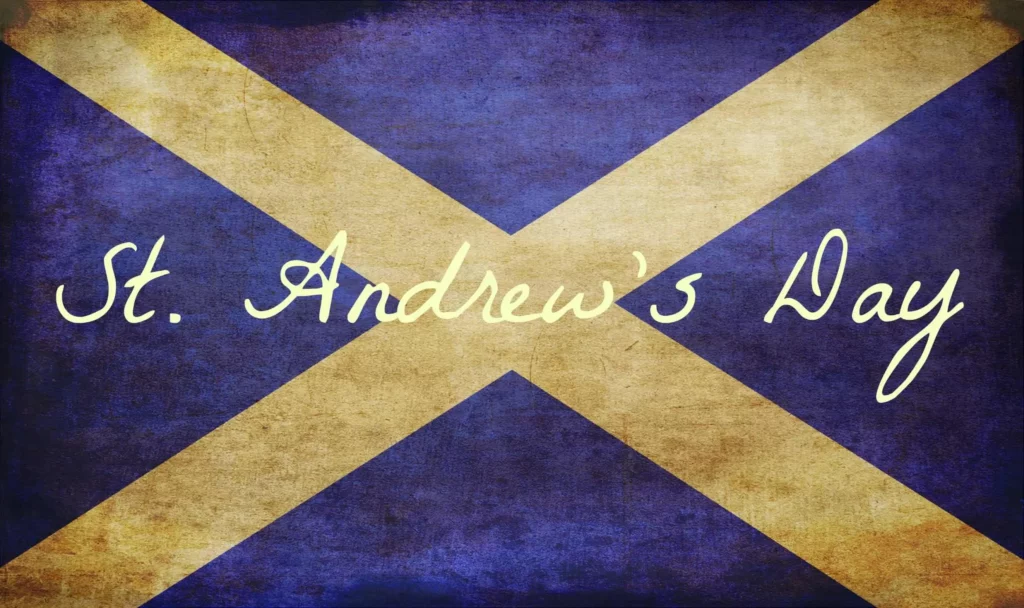In Scotland and throughout Europe, St. Andrew’s Day, which is observed on November 30 every year, is regarded as a national holiday. St. Andrew was an apostle who not only led his brother, Peter, to Jesus but also assisted Scottish King Oengus I in winning a key conflict against Northumberland, ensuring Scotland’s safety. He is revered as the patron saint of Scotland, Romania, Greece, and many other nations in Europe. In Greece in the year 60 AD, St. Andrew was crucified on a saltire, an “X”-shaped cross, and died as a martyr.
When is St. Andrew’s Day
Andrew the Apostle is honored on Saint Andrew’s Day, also known as the Feast of Saint Andrew or Andermas. On November 30th, it is observed. The disciple named Andrew is the one who introduced the Messiah, Jesus, to his brother, the Apostle Peter, in the New Testament.
St. Andrew’s Day History
Simply said, Scotland’s patron saint is St. Andrew, an apostle of Jesus. As a result, feasts in Andrew’s honor have been conducted in Scotland for more than a millennium, dating back to the year 1000 AD. However, he did not formally become Scotland’s patron saint until 1320, the year the country gained its independence. Since that time, Andrew has assimilated into the nation. In his honor, the St. Andrew’s Cross became the national flag of Scotland. Its claim to be the location of his ultimate resting place also led to the old town of St Andrews receiving its name.
But why does Scotland rely on him so much?
In the New Testament, Andrew is described as having accompanied Jesus on a few significant occasions. For instance, Philip told Andrew first when he wished to tell Jesus about the Greeks who were seeking Him, and Andrew then told Jesus about the boy who had the loaves and fishes. Andrew, who had been at the Last Supper, was one of the four disciples who came to Jesus on the Mount of Olives to ask about the signs of his coming at the “end of the age.”
Unexpectedly, America is involved in St. Andrew’s Day. In 1729, Andrew’s Society of Charleston was established in South Carolina. The group is the oldest Scottish society of its kind in the world. St. Andrew’s Day is currently one of the three important occasions that occur during the winter. On November 30, people all around Scotland come together to honor Andrew and have a wonderful time, kicking off the Winter Festival. Typically, parties last until the wee hours of the morning and include dancing, music, food, and drink as part of a celebration of Scottish culture.
St. Andrew’s Day Activities
Host your own St. Andrew’s celebration.
Bring your friends together and enjoy a meal of haggis, porridge, black pudding, and whisky! Create some entertaining trivia about St. Andrew himself while you’re at it. Did you know that he was also a fisherman?
Don a kilt
Even while it may not be a national holiday in America, we are all, at our core, Scots. Wear a kilt, decorate your face with the Scottish flag’s traditional blue saltire, and call it a day on St. Andrew’s Day!
After learning how much fun it is to celebrate St. Andrew’s Day, go to St. Andrews prepared to purchase a one-way ticket to Scotland. From November 30 to December 3, you can find Scots celebrating all over Europe, but St. Andrews, with its rolling landscapes, rich history, and traditions, is the best place to celebrate.
St Andrew’s Day Facts
- St Andrew’s Day celebrations have been taking place in Scotland for over a thousand years, there is evidence of feasts being held in his honour as far back as 1000 AD.
- When Scotland declared independence with The Declaration of Arbroath, St Andrew became the region’s patron saint.
- St Andrew’s cross is featured on the flag of Scotland.
- The town of St Andrews was named so as it is claimed to be the saint’s final resting place, but it is believed Saint Andrew never actually stepped foot in Scotland.
- Although Andrew is proudly revered as Scotland’s patron saint, he is also the patron saint of Barbados, Georgia, Ukraine, Russia, Poland, Sicily, Greece, Cyprus, Romania, Patra, Tenerife, and Malta.
Messages from Saint Andrews Day
On the occasion of St. Andrew’s Day, may you and your loved ones are blessed with eternal happiness and smiles.
May the occasion of St. Andrew’s Day brings along lots of blessings for you and your family for a beautiful future.
St. Andrew will always be in the hearts of all Scottish people and we will always respect him as long as we live!
If you want to change the world, use love and kindness and, with this thought, here wish everyone a very happy St. Andrew’s Day!
If you read through history you will get to know that St. Andrew had really proper thoughts and beliefs and, with that thought, let us celebrate this St. Andrew’s Day!
Saint Andrews Day Quotes
‘The birth-place of Valour, the country of Worth;
Wherever I wander, wherever I rove,
The hills of the Highlands for ever I love.’
— Robert Burns
- ‘I love Scotland – I was made an honorary Wallace after my work on ‘Braveheart,’ you know. If I have two or three days off, I love nothing more than driving up there and climbing around Glencoe.’ – Brian Blessed
- ‘I look upon Switzerland as an inferior sort of Scotland.’ – Sydney Smith
- ‘The mark of a Scot of all classes [is that] he…remembers and cherishes the memory of his forebears, good or bad; and there burns alive in hims a sense of identity with the dead even to the twentieth generation.’ – Robert Louis Stevenson.
- ‘I’m William Wallace, and the rest of you will be spared. Go back to England and tell them… Scotland is free!’ – William Wallace
- ‘Scotland should be nothing less than equal with all the other nations of the world.’ – Sean Connery
FAQs about Happy St Andrew’s Day
What is St. Andrew’s Day?
St. Andrew’s Day is the feast day of Saint Andrew, a Christian apostle and the patron saint of Scotland. It is celebrated on November 30th each year.
Who was St. Andrew?
St. Andrew was one of the twelve apostles of Jesus and is recognized as the brother of Saint Peter. He is the patron saint of Scotland, as well as several other countries.
How is St. Andrew’s Day celebrated?
Celebrations vary, but they often include traditional Scottish food, music, and dance. Many people attend special church services, and there may be parades and events in honor of the day.
Is St. Andrew’s Day a public holiday?
St. Andrew’s Day is a public holiday in Scotland. While it is not a public holiday in other parts of the United Kingdom, some people still choose to celebrate it.
What are some traditional Scottish dishes eaten on St. Andrew’s Day?
Traditional Scottish dishes enjoyed on St. Andrew’s Day include haggis, neeps and tatties (turnips and potatoes), and various types of Scottish desserts.
Are there specific symbols associated with St. Andrew’s Day?
The saltire, or St. Andrew’s Cross, is the national flag of Scotland and a symbol associated with St. Andrew. It features a white saltire on a blue background.
Do people exchange gifts on St. Andrew’s Day?
While gift-giving is not as common on St. Andrew’s Day as it is on other holidays, some people may exchange small tokens or gifts, especially within families.
Is St. Andrew’s Day only celebrated in Scotland?
St. Andrew’s Day is primarily celebrated in Scotland, but people of Scottish descent in other parts of the world may also observe the day.
Are there any special events or festivals for St. Andrew’s Day?
Yes, there are often events and festivals held in various parts of Scotland to mark St. Andrew’s Day. These may include concerts, parades, and traditional Scottish ceilidh dances.
Can non-Scots celebrate St. Andrew’s Day?
Absolutely! St. Andrew’s Day is a celebration that welcomes everyone. You don’t have to be Scottish to enjoy the traditions, food, and festivities associated with this special day.




